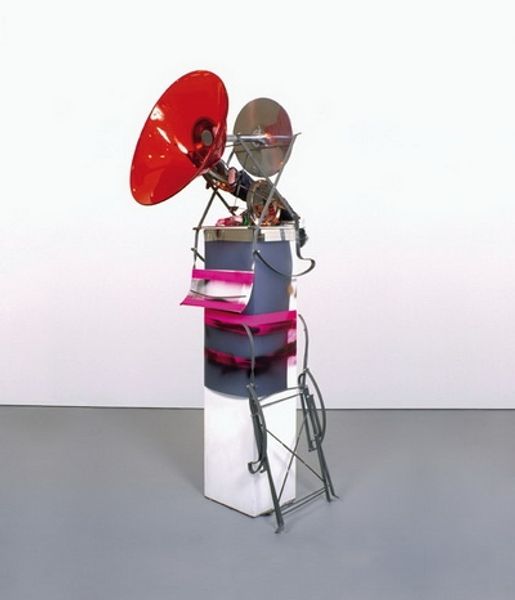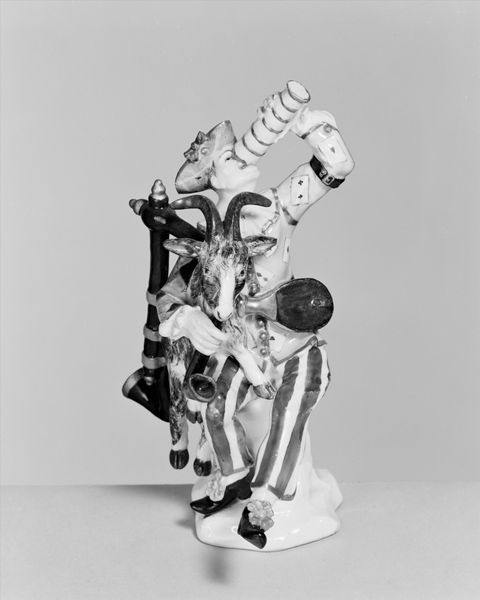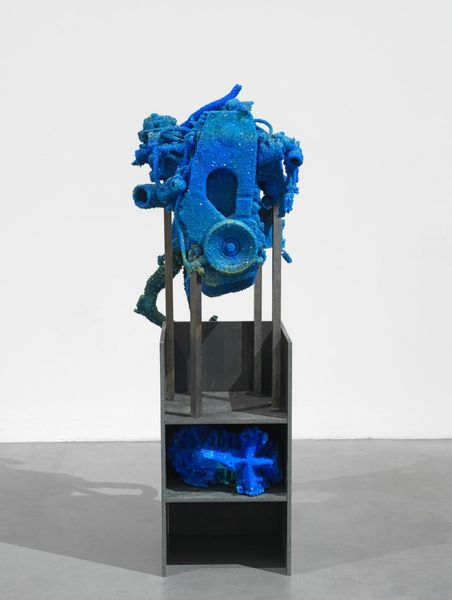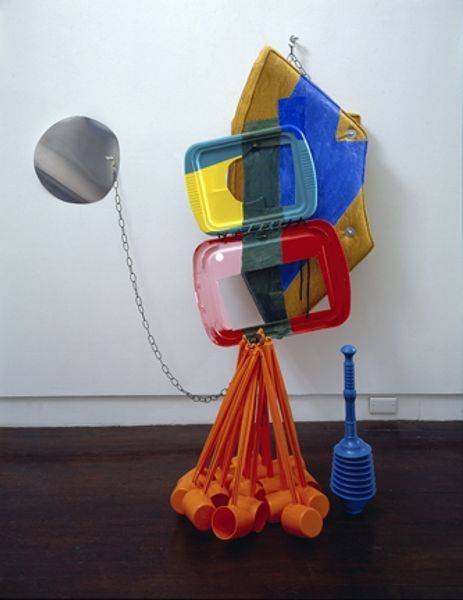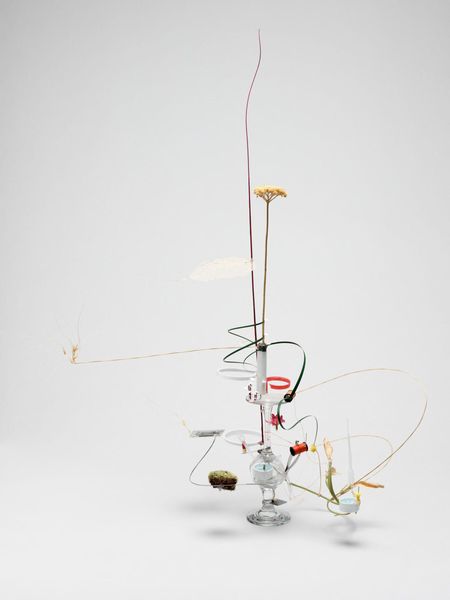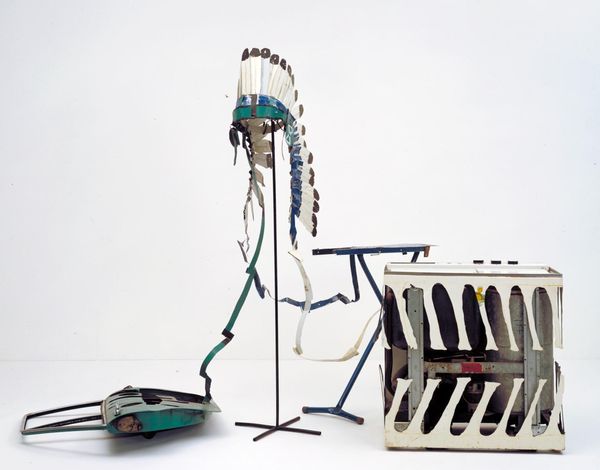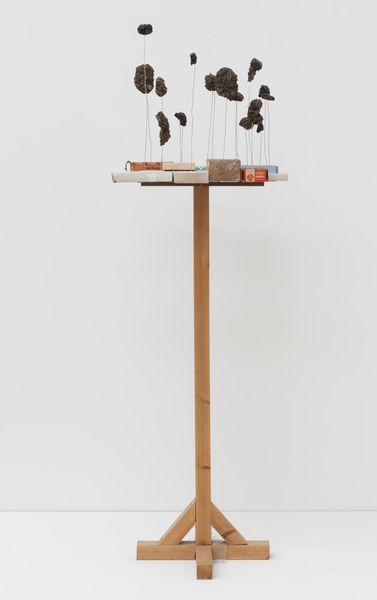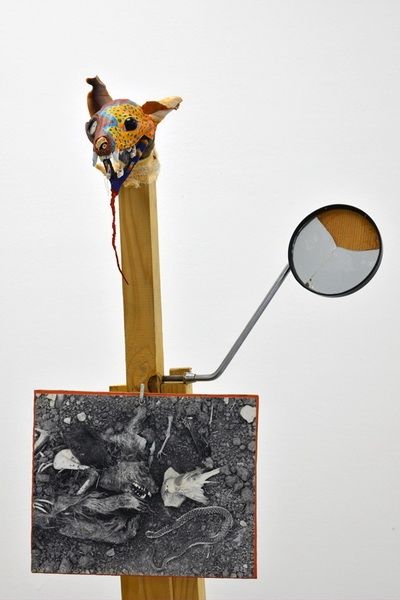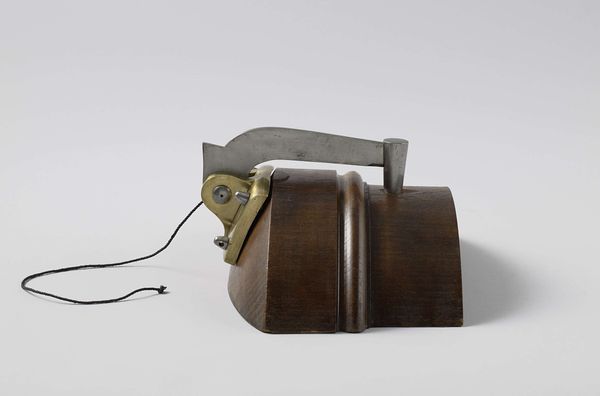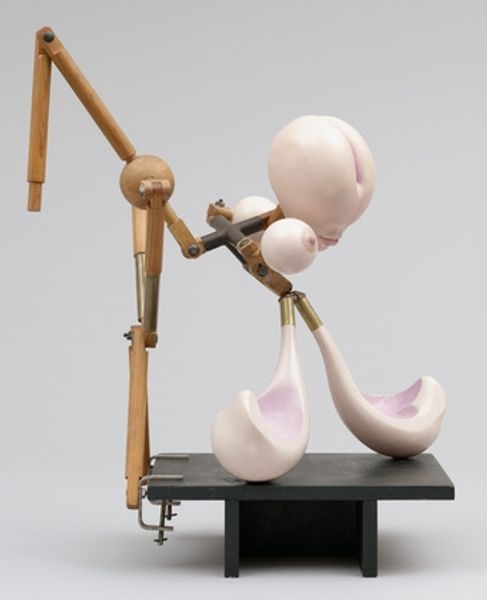
Dimensions: displayed: 1500 x 1650 x 730 mm
Copyright: © Bruce Lacey | CC-BY-NC-ND 4.0 DEED, Photo: Tate
Curator: Bruce Lacey's "The Womaniser" presents a rather peculiar tableau of found objects, wouldn't you agree? Editor: Indeed! The composition is striking—the unsettling juxtaposition of textures and forms creates an immediate sense of unease. Curator: Lacey, born in 1927, often worked with repurposed materials. Consider the implications of using discarded objects to construct this… apparatus. It hints at themes of labor, consumerism, and perhaps even obsolescence. Editor: Absolutely. The orange inflatable form, the mannequin head, the pink gloves—they coalesce into a grotesque parody of the human form, amplified by the clinical setting. What do you make of the overt symbolism? Curator: It’s a commentary on societal obsessions, exploring the male gaze. Lacey's creation reflects the complexities of gender and objectification within the cultural context of his time. Editor: A powerful and unsettling assemblage that encourages us to examine our own assumptions about desire and representation. Curator: Quite. The crude construction lays bare the processes of objectification, asking us to look beyond the surface.
Comments
Join the conversation
Join millions of artists and users on Artera today and experience the ultimate creative platform.
tate 7 months ago
⋮
The Womaniser is an assembled figure reclining in a Victorian dentist's chair. The torso is represented by an inflatable orange vinyl cylinder, which was probably once some sort of floating, or life-saving, device. The legs are both metal artificial limbs. The Perspex head, which came from a school teaching aid, is filled with clippings from pornographic magazines. (When The Womaniser was exhibited in 1993 the artist replaced these with recent cuttings but, finding the more graphic nature of their content disturbing, he resorted to the tamer originals). The face has a rubber mask, originally used in teaching mouth-to-mouth resuscitation, which has perished considerably. A clear plastic stand for displaying bras in a shop sits on top of the torso to provide three pairs of breasts. Rubber gloves resting on each of the breasts are attached by wartime field-dressings to tubes through which air is provided by a pump driven by the motor of an old refrigerator. Every thirty seconds the gloves inflate and become erect, after which they deflate, vibrating as if fondling the breasts. The figure is clearly hermaphrodite, as the pipe for inflating the torso rises between the legs like an erect penis. Photographs show that there was originally a mouth just above this pipe (Reliefs/Sculpture, exhibition catalogue, Marlborough New London Gallery, London 1966, [p.13]). The Womaniser was made in London. The artist has said that this piece related to his fantasised image of himself as a womaniser. He felt that, in the mid 1960s, there was a common image of the male womaniser with which he did not identify. One can read this assembled figure as a satirical comment on sexuality and its commodification. The figure presented is shown to be licentious and lustful, his head stuffed with pornography as he gropes several pairs of breasts. The inclusion of a rubber mask used by nurses while practising artificial resuscitation presumably signifies a lack of emotion with its suggestion of a distanced kiss. That the figure is both male and female emphasises, perhaps, a certain self-regard. In this respect, Lacey recalled that when The Womaniser was first shown he positioned one of the gloves so that, as it inflated and deflated, it seemed to masturbate the 'penis', while the remaining gloves stroked the 'breasts' (interview with Tate curator, 4 Sept. 2000). The original positioning of an open mouth above the 'penis' may be a reference to a similar auto-eroticism. At the moment that performance art was emerging, Bruce Lacey bridged the divide between fine art and popular performance. Having trained as a painter, he made trick props for comedy performances on stage and television and became a cabaret artist himself, most notably with comic jazz musicians The Alberts. His assemblage sculptures, the first of which was made in 1962, grew out of these activities. With these he brought together a range of, often domestic, detritus to make objects which used absurdity to satirise aspects of contemporary life. He wrote later: 'The objects I make are hate objects, fear objects and love objects. They are my totems and fetishes …It's what I feel about life, about people. Life is not a pretty thing; these are not pretty things' (statement in Bruce Lacey: An Exhibition of Humanoids and Constructions, exhibition catalogue, Arts Council Gallery, Cardiff 1967, unpaginated). The works reflected the artist's rejection of aesthetics just as the use of found objects indicated his engagement with real life. 'Art shouldn't just be stimulating man intellectually, or emotionally … it should instead be awakening his conscience and his awareness of life as it is and what it is going to be, as we move forward to a frightening future where man's very individuality and personality may be lost' (Bruce Lacey 1967). Further reading:Bruce Lacey: 40 Years of Assemblages, Environments and Robots, Whitechapel Art Gallery, London, Feb.-April 1975 (25) Chris StephensNovember 2000
